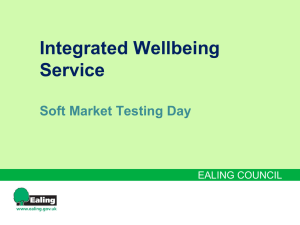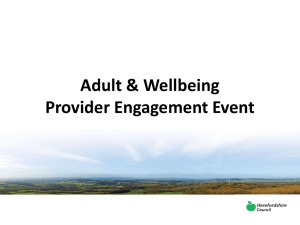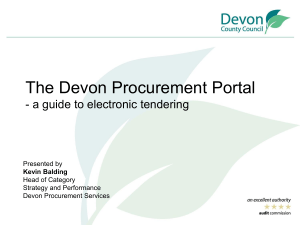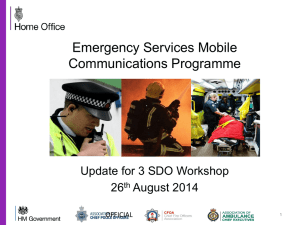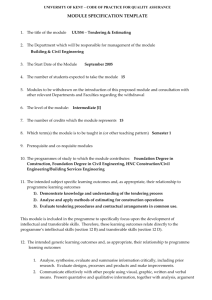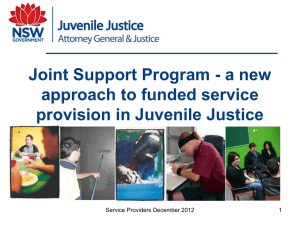Ealing-Commissioning-and-Tendering
advertisement
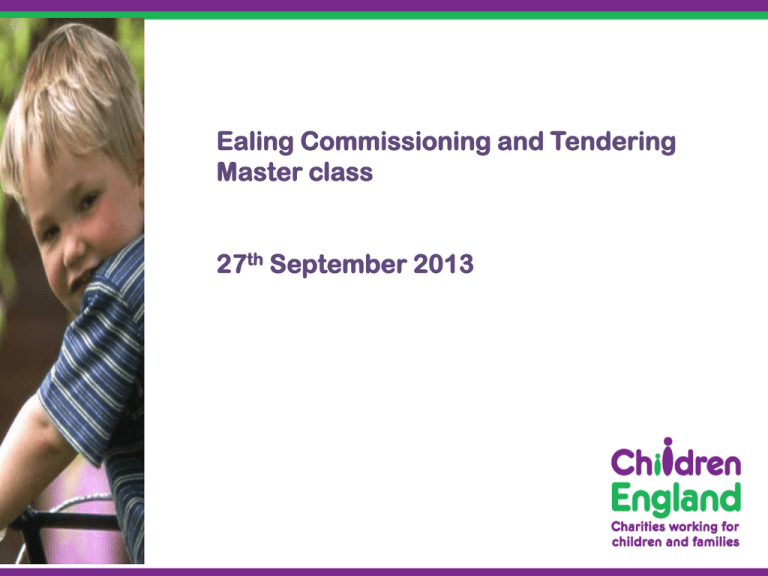
Ealing Commissioning and Tendering Master class 27th September 2013 Aims and Objectives: •Introduction to Children’s Commissioning in Ealing •The tender process and submitting high quality bids •Demonstrating value for money and outcomes •Accessing contract opportunities •Bidding on a Joint or Solo basis THE TENDERING PROCESS 11AM TO 11.30AM Commissioning, Procurement, Tendering & Contracting Commissioning describes the whole process of mapping, planning, delivery and evaluation of services for a local area. A commissioner is anyone undertaking this whole process. Commissioning, Procurement, Tendering & Contracting • Procurement refers to the purchase of services, usually by publicly funded bodies, at the best possible price, in the right quantity and quality, at the right time and generally via a contract. It is one part of the commissioning process • Tendering is the process of making a formal offer in writing to provide services as specified in the tender documents. Successful tenders result in the awarding of a contract • Contracting is about one organisation, such as a local authority paying another to deliver a service to an exact specification as laid out and agreed in a contract Procurement Procedures • TOTAL ESTIMATED VALUE PROCEDURE • Up to £10,000 Officers should proceed in a manner most expedient to the efficient management of the service. • £10,001 - £35,000 Three written quotations as a minimum. • £35,001 - £75,000 Invitation to Tender to at least three tenderers. • £75,001 – EU Threshold Invitation to Tender by advertisement. • Above EU Threshold EU Tendering procedure. PROPORTIONALITY , the PROVIDER MARKETS and the NATURE OF THE SERVICES TO BE DELIVERED, all determine how the Tender process WILL BE DESIGNED & UNDERTAKEN - EACH TENDER IS DIFFERENT !! EU Procurement Directives (at present) Part B (Residual) Services Part A Services (Most of Social Care Service delivery contracts fall into Part B Services ) EU Requirements for tendering Part B Services: • Financial threshold • A technical service specification and Publication of contract award OJEU • Set by the prevailing case law. CHANGING IN 2013 – UK may be an earlier implementer of the changes (yet to be agreed) The ‘common’ Tender Process Advert Placed Seek EOI Monitoring Send out PQQ Award Interview PQQ Evaluation Submission of ITT ITT Common requirements of a Pre-Qualification Questionnaire • • • • • • • Legal status Previous relevant experience Resources, Qualification and Accreditations Financial information – to size of the contract Policies and Procedures – ‘SAFEGUARDING’ Equality & Diversity Quality Assurance - ISO 9001, NYA Youth Service Quality Mark, PQASSO, EFQM • Insurances – Employment & Public liability Professional Indemnity • References Completing the PQQ • Pay attention to the scoring (if given) • Read through the whole document and thoroughly understand what is being asked of the whole PQQ - in some cases questions can be confusing & often duplicated in the application form and can be interpreted in a number of ways • If in doubt – ask ! • Put yourself in the shoes of the evaluator who can only score you on what you put down on paper • Financial health check • Check you have the relevant insurances in place • Update policies and procedures with current legislation • Contact referees in advance - time is of the essence. Common requirements in an Invitation to Tender • Ability to meet the service specification and provide evidenced based service solutions to meet target group and deliver outcomes • Evidence ability to deliver the service, previous experience and knowledge of working with the need group and qualifications to do so. • Ability to set up and delivery the service and the business skills in running the service – submit business plan. • Ability to work in partnership and how this will be achieved. • Ability to measure impact and outcomes. • Evidence the embedding of policies & procedures within your organisation. • Ability to engage & consultant with target group to inform services FEATURES OF A SUCCESSFULL BID 11:45 to 13:00 What makes a good tender submission? S – SPECIFICALLY ADDRESS ALL THE SERVICE SPECIFICATION REQUIREMENTS M -CLEAR MEANS OF MEASURING NEEDS AND SUCCESS OF THE PROJECT A –THE BUSINESS PLAN, MODE OF SERVICE DELIVERY AND OUTCOMES ARE ACHIEVEABLE R - THE SUBMISSION IS REASLISTIC T - THE SERVICE CAN BE SET UP, IMPLEMENTED AND DELIVERED IN THE REQUIRED TIMESCALES AND THE ORGANISATION HAS EVIDENCED ITS TECHNICAL ABILITY TO DELIVERY THE SERVICE Preparation ...preparation...... • Read through the entire Initiation to Tender (ITT) • Assess the risks, investment required and engage key stakeholders. • Think about each of the questions and ensure you understand what each question is asking. • Look at the evaluation scoring. • Develop project plan to complete the submission. • Pay attention to the ITT clarification questions and answers • Attend provider briefing sessions. • Ask questions and seek clarification where required. • Do not leave the submission until the last minute. Exercise 2: • Critiquing previous tender submissions (examples only for the purpose of this training) • Ratings 1 – 5 (1 low and 5 highest score) • Indentify areas for improvement Key learning points • Plan your answers • Evidenced base should be on service solutions and how will risks be mitigated • Ability to link best value, service sustainability and achieving specification requirements and outcomes • Flexibility of service provision • Continuous monitoring Pitfalls to avoid • • • • • • • • • Answer did not address the question. The submission made no explicit link to the outcomes required, it was implied but not explicit. Lack of specificity in meeting the described needs and understanding the complexity of need. Services were based on existing provision with little explicit reference to meeting the requirements of the service specification. Limited explanation given as to what is to be provided (assumed awareness of the organisation’s ability to provide a service) Services were too expensive as it included provision not required No reference was made as to how referrals would be received and how assessment of needs would be undertaken. No information given as to how the provider would communicate with other professionals. Business plan did not address the management of risks , contingency planning or interim service arrangements. Continued..... • Sell our service • Give good introductions to answers • In all your tender answers keep referring back to the service specification requirements • Understand and answer the question. • Ensure all your answers address the requirements of the question. • Try and quantify added value and evidence why the added value components will be beneficial to the services being procured. • State the purpose and objective of engaging users in the deliver of the service and why this is considered to be beneficial. BE EXPLICT, CLEAR AND CONCISE, CROSS REFERENCE ANSWERS TO THE SERVICE SPECIFICATION LUNCH 13:00 TO 13:45 BUILDING THE FUTURE? What could the future hold ? Prior or early notification of tendering opportunity • • • • • • • Networks Preparation Fact and knowledge finding – needs and outcome data Indentify partners / potential collaborators Get ready to tender Assessment of risk Planning and resourcing DOING THE BUDGET 14:30 TO 15:00 • • • Benchmarking...evidencing Best value Know your USP and the cost of your service Research Benchmark – Remit/scope of the service – Partnerships & Collaboration – Location, – Accessibility, – Complexity of need, – Number of staff / volunteers (staffing ratio) – Staff turnover, – Training & Qualifications of staff, – Other funding arrangements – Full cost recovery, – Number of activities sessions or outputs to be delivered, – Price, – Timescales of service delivery Significant number of variables are involved when benchmarking thus care should be taken!!!!!!!!!!!!!! Benchmarking Short Break Services Service type Costs – Short break services for disabled children • Residential overnight £69.97 – £373.00 per child per night (24 hour period) • Family based overnight £140.36 - £226.26 per child per night (24 hour period) • Day care £99.21 – £204.83 per child per session (8 hours) • Domiciliary home care £16.74 – £25.60 per family per hour • Home support £17.54 – £25.60 per family per hour • Home sitting £10.98 – £26.07 per family per hour • General groups £296.68 - £430.61 per session • Afterschool clubs £239.77 - £331.17 per session • Weekend clubs £296.68 - 324.17 per session • Activity holidays £113.38 (for a 2 day break) - £3,701.15 (7 day break) Reference: Research Report DCSF-RR224 The Costs of Short Break Provision (March 2010) Not intervening early is expensive…. Cost per child / family Child looked after in children’s home – £125,000 per year placement costs Multi-dimensional Treatment Foster Care – £68,000 per year for total package of support Child looked after in foster care – £25,000 per year placement costs Family Intervention Projects – £8-20,000 per family per year Parenting programme (e.g. Triple P) – £9001,000 per family Multi-Systemic Therapy – £7-10,000 per year Family Nurse Partnerships – £3000 per family a year PEIP – £1,200 3,000 per parent Children’s Centres - around £600 per user Schools - £5,400 per pupil Severity of need Child looked after in secure accommodation – £134,000 per year placement costs Cost Costs increase as children get older DECIDING WHAT TO DO NEXT ? Solo or Joint Enterprise 15:00 to 15:40 Partnership / Consortia submissions Types of Collaborative working – Scaling up – Sheltering – Merging – Sub-contracting – Consortium Models of Consortia Working: Informal Network charity 2 Commissioning Body Charity 3 charity 1 Contracts Charity 4 Charity 7 Charity 5 Charity 6 Lead Agency Formal Consortium Partnership / Consortia submissions – factors to consider • Maintaining independence and remaining true to mission • Effective governance arrangements • Risk assessment and mitigation • Protecting charitable resources and ensuring that they are used appropriately Partnership / Consortia submissions www.locality.org.uk Contact Details membership@childrenengland.org.uk training@childrenengland.org.uk www.childrenengland.org.uk Tel: 0207 833 3319

